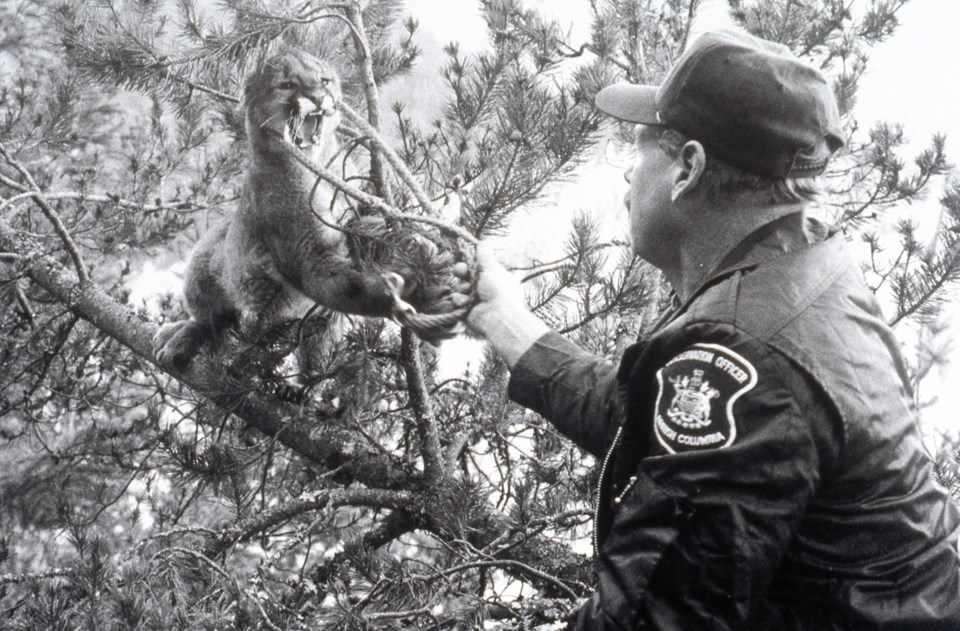Dennis Pemble knows how it feels to stand face-to-face with a growling cougar.
The retired wildlife control officer also knows how it feels to have that animal's life in his hands.
He recounted an instance when a cougar was spotted in residential areas in Squamish, killing pets. Pemble was tasked with resolving the issue. His hounds had driven the young cougar into a tree, suspended over a cliff.
“If I tranquilize it, it's gonna fall off a cliff and die,” he said. “My only other option is to shoot it, because if we just let it go, it's going to go back and start killing dogs and cats again.”
Instead, Pemble tied a few dog leashes together into a makeshift lasso. “It took me quite a few tries, but I finally got the lasso around its neck and I pulled the cat out of the tree,” he recalled. He and two other officers managed to tranquilize and relocate the animal.
An image of that encounter graces the cover of Pemble’s book, The Last Wildlife Control Officer in British Columbia: Thirty years of dealing with problem predators.
Published in March of this year, it features 36 short stories about the most compelling, adrenaline-pumping run-ins Pemble experienced in his 30 years on the job, spanning from the late 1970s to his retirement 15 years ago. Pemble and his wife Karen, who live in Abbotsford, co-wrote the memoir from their Shuswap Lake cabin over several months, drawing from the detailed daily diaries Pemble was required to keep over those three decades. It has already earned a spot on FriesenPress’ best sellers’ list.
Pemble said the idea for the book came from the numerous journalists who joined him for a ride-along over the years, from publications like Smithsonian Magazine, Los Angeles Times Magazine, and Reader’s Digest. “They said to me over the years, ‘You’ve got to write a book.’ And they kept saying it,” he remembered.
But “author” wasn’t a title Pemble expected to add to his resume. Aside from wildlife encounters, Pemble’s book veers into vulnerable territory, describing a boy who struggled in classroom settings: the seventh of nine siblings, he attended six different schools before Grade 8 and struggled with a learning disability in the days where teachers “didn’t know what to do with kids who didn’t learn the way mainstream kids did,” he writes.
He failed a few grades and was even placed in a remedial learning class before leaving high school after Grade 10. But his years in the classroom did provide Pemble with one benefit: an elementary school friend, Dan, whose family Pemble credits with changing his life. Dan’s father, Jack Lay, was the province’s animal control officer in charge for the Lower Mainland. The family kept hounds they used for tracking and hunting. Pemble would often join in.
Years later, that friend gave Pemble a call: Lay was looking to hire a seasonal coyote trapper. The only issue? Pemble needed a high school diploma to work for the provincial government. The opportunity spurred Pemble into a 10-month equivalency program. He passed, earning a Grade 12-equivalency certificate and a job.
In Pemble’s second trapping season, Lay retired, and urged Pemble to apply for his position.
“I did, thinking I didn’t have a hope in hell of getting it,” Pemble writes in the book. Pemble not only got the job, but went on to spend “30 years chasing grizzly bears, cougars and black bears and anything that was causing problems with human safety or livestock,” he told Pique. Those pursuits pulled him across the Lower Mainland, from the Fraser Canyon and Manning Park to the Sea to Sky corridor and Sunshine Coast.
According to Pemble’s records, he dealt with 45 grizzlies, 709 black bears, 161 cougars, 495 coyotes and five wolves over the course of his career. “I also [responded to] thousands of complaints,” he said. “I didn’t get every animal that I went out to find.”
Of those 45 grizzlies, he shot just two. One was charging him, the other was “skin and bones,” after breaking into a logging camp cookhouse, and wasn’t suited to relocation. The province hired Pemble full-time in 1978 “to go out and pretty much shoot every animal that was a problem,” he remembered. “I was lucky I was given a tranquilizer gun so I took it on myself—because my bosses kind of let me do whatever I needed to do—and I started tranquilizing.”
Those relocation attempts weren’t always successful, as was the case with two separate livestock-killing grizzlies Pemble caught in the Pemberton Valley. One was released in Manning Park, near the U.S. border, the other on the far side of the Fraser Canyon. Both were radio-collared, and both returned to Pemberton in short order. “In one month, [one] was back in the same turkey shed,” Pemble recalled. “The farmer shot him and killed him.”
Still, the government’s approach to wildlife has shifted since the ’70s, and even in the 15 years since his retirement, Pemble acknowledged, putting more of the onus on the public to manage wildlife attractants. “They fine people for having garbage out,” he said. “It's changed a lot.” Those changes are “wonderful,” in Pemble’s view.
When he retired, the province “went straight to contracting hound guys, hiring local trappers,” he said. Now, “the conservation officers are doing some of the duties that I was doing.”
Pemble was the last British Columbian to hold the title of wildlife control officer.
You can purchase a copy of The Last Wildlife Control Officer in British Columbia: Thirty years of dealing with problem predators online from FriesenPress, or order from Whistler’s Armchair Books.



